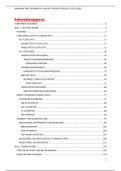Summary
samenvatting organisatie van het productieproces 2020 KUL
- Course
- Institution
Uitgebreide en duidelijke (allesomvattende) samenvatting van het vak 'organisatie van het productieproces' in 3e jaar bachelor TEW aan KU Leuven. Ik haalde 17/20 met deze samenvatting.
[Show more]



